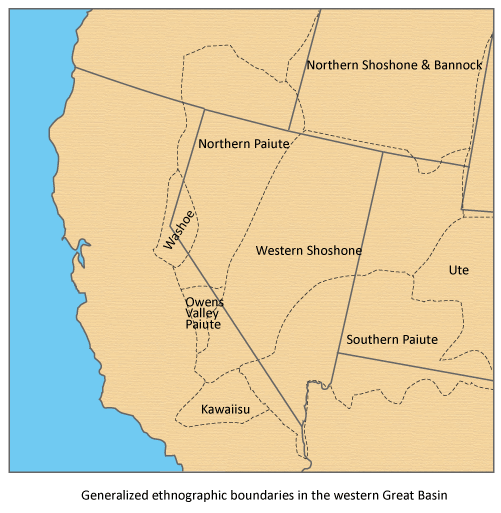Great Basin Peoples
One of the most frequent questions asked about rock art is Who made it? Did ancestors of today's Great Basin tribes make the rock art? Did an earlier people create it? And why did people make it and what did it mean? Places such as Grimes Point or Valley of Fire are landmarks to the lives of the archaeological cultures and ancestors of Great Basin tribes. Modern day Northern and Southern Paiute, Washoe and Shoshone peoples were the inhabitants of this large arid region we call the Great Basin. An area of interior drainage that spans most of Nevada, the Great Basin demanded sophisticated but portable knowledge and technology of its inhabitants to successfully live in this arid environment.

Long description
Mark Twain is infamous for denigrating the Gosiute Indians of western Nevada as "inferior to even the despised Digger Indians of California" (Roughing It, 1872). What Twain and others failed to recognize was the brilliance of the Great Basin Indian peoples who used a digging stick, among other tools, to successfully locate and harvest foods in a landscape that appeared to Euro-Americans as desolate and inhospitable.
The early inhabitants of the Great Basin are classified as foragers, or hunter-gatherers, by anthropologists. Their way of life was characterized by small groups of people moving across the landscape following known and predictable seasonal harvests of non-domesticated animals and plants. These small groups built shelter of minimally processed materials (such as sagebrush or tree branches); used implements and wore clothing woven from available fibers (willow, grasses, and reeds) and hides (rabbit, deer, and mountain sheep); shaped stone tools from local quarries (obsidian and chert) and bone tools from butchered animals; utilized local bedrock for grinding of seeds and nuts; and kept their most valuable tool, knowledge, within their prodigious memories, aided by song, story and myth. Artistic and social expression found outlet in daily artifacts, verbal arts, and—the most enduring form—rock art.
Foragers are often described as living in an egalitarian social structure, or at least the most egalitarian social structure known among human beings. Even among a group of equals, however, the division of labor followed gender lines (men hunt: women gather), and a group of semi-specialists emerged, the so-named shaman or Indian doctor. At its heart, however, the forager life way required that all contribute direct labor to the business of living.
Small populations, high mobility, and complex oral knowledge allowed the Great Basin Indians to live in a vast expanse of land that was among the last to be colonized by Euro-Americans. Unified by a basic life way but separated by language and regional adaptations, the tribes of the Great Basin narrate their own history as having been in place since the beginning of time. Archaeologists, however, suggest that the current tribes may have entered the Great Basin somewhere around 1500 years ago, replacing an earlier population of people.
One of the more intriguing conundrums in the study of rock art is the scarcity of ethnographic information about its creation and use. Various methods of relative dating indicate that most rock art dates from around five thousand to one thousand years ago, suggesting perhaps that it was the earlier population of inhabitants who created most of the rock art seen today. Other clues buried in the earliest ethnographies suggest, however, that the highly socialized and ritualized functions of rock art may have been among the earliest knowledge to get lost during Euro-American encounters and subsequent colonization.
Regardless of who made it or when, the enduring monumental form of rock art continues today to inspire and attract many visitors from diverse backgrounds across the globe. Whether a forager from five thousand or five hundred years ago, the makers of these sites left us priceless marks of their time on earth. As you visit these great outdoor galleries, put yourself in footprints thousands of years old and treat these masterpieces with the reverence and respect they deserve.
